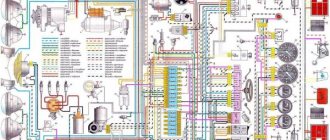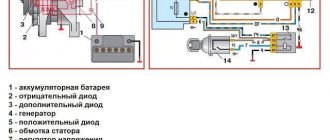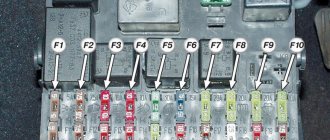How to increase the onboard voltage is very simple.
Where and how is a diode placed in the LV circuit on the generator in order to increase the voltage in the car network and better charge the battery?
Here I propose a simple solution, raising the on-board voltage, without going anywhere in the car and its circuits. I searched in my archives and did not find the material from which I read this decision. “Structurally, voltage regulators have an upper limit of 13.6V. This is due to the “old” connection diagram, from which the new one was copied and “successfully improved”. In it, the necessary voltage from the on-board network, supplied to the regulator for comparison, passed through a chain of wires. On them it dropped to normal. According to the new scheme, we have a chronic undercharge of the battery. Which, with the arrival of winter, makes starting the engine in the cold quite problematic. But if you install a pre-heater, starting the engine will be much easier.
It should also be noted that the battery begins to absorb energy (charge) only when its temperature is above zero. Therefore, in winter, if you make short runs and the battery does not have time to warm up under the hood to at least zero (plus charging time), it will be constantly discharged. And soon it will die... It is believed that after starting the engine, in order for the battery to recover, you need to drive for at least 20 minutes. Just go, and not stand in traffic jams! How to increase the voltage in the network?
Very simple! It is necessary to make the regulator “think” that we have low voltage in the network. Thus, the generator will give us the missing volts. A diode will help us do this. In a generator with a built-in voltage regulator, you need to place a diode in the circuit, as shown in the figure.
To watch online, click on the video ⤵
What if the charging relay malfunctions and charges the battery incorrectly? Using the GAZ-2705 as an example Read more
No charger for your gazelle? there is a solution! More details
Charging gazelle. Car repair of a gypsy chaise. Linen-factory. Kaluga Read more
Everyday life of a sovkovod. No charging. Gas 2410 dvs 402 Read more
Charging, Volga 402 engine Read more
WEAK CHARGING? SOLUTION IN 5 MINUTES AND THE GENERATOR WILL BE LIKE NEW. More details
Low voltage on the gazelle generator Read more
Low battery charge | ZMZ 406 More details
How to increase the charging current on a gazelle is one way. More details
Replacing the Gazelle Volga voltage relay with a three-level voltage regulator relay Read more
How to increase the voltage in a GAZelle car Read more
How to check the generator on a car. Basic malfunctions. Simply about the complex Read more
Never do this and there will be no problems. And if it's already done, here's how you can detect it. More details
we increase the voltage of the generator VAZ 2110-2111-2112 Priora Kalina, etc. Read more
Reasons for the battery not charging. More details
Diagnostics and repair of Generator VAZ, Gazelle, Volga, Sable, Lada, Priora Read more
The generator does not charge. Bad charging. Generator repair. More details
Quick check of the generator outside the car Read more
How to increase generator voltage Read more
Description
A generator is an electrical machine whose main purpose is to convert mechanical energy into electrical current. In a car, this element is used not only to charge the battery, but also to power other electrical equipment (for example, the computer and ignition system) when the engine is running. The Gazelle uses an alternating current generator. It is located in the front of the engine, on the left side next to the main radiator.
As for the characteristics, the Gazelle generator produces a maximum voltage of 14 Volts. Peak current can range from 65 to 120 amps, depending on the model. But the generator is installed with a power of no more than 80 amperes. And if we consider the first modifications (95-2002), then it’s 60.
Panel "Euro-1"
This tidy was installed on both “Sable” and “Gazelle” of all modifications. The reader can see what its design is in the photo below.
From a distance, this shield resembles the panel of the Zhiguli-seven. But still, this is an original development. There are no electronic signs here. Only available:
The shield was produced in this form for about eight years. No changes were made during this period.
What kind of charging should go to the battery from the generator?
It is traditionally believed that 13.5-14.5V should be supplied by the generator to the battery and this is absolutely enough to replenish the battery costs.
It is worth considering that using a battery with a higher power in a car than the manufacturer recommends also requires the installation of a more productive generating device.
It is necessary to take into account the load that the generator must withstand - it is calculated based on the maximum indicators of all electrical appliances and car systems.
Do not forget that the charging current from the energy-generating device will allow you to start the car in the cold season. In order to avoid problems with starting the car, we recommend purchasing generating equipment, the charge current of which will be approximately 10% of the capacity of the power source. That is, a battery of 100 A/h requires a generator that can produce 10A. Please note that for many cars, 100 amp equipment will operate at its maximum capacity, because the power consumption of the automotive system is in the region of 80 amps. Therefore, the choice of a source generating energy must take into account both the battery capacity and network consumption.
Reasons for failure
If the symptoms described below appear, carry out diagnostics. You can do it yourself or take the car to a car service. To determine the cause of the failure, special equipment is needed. If you decide to figure it out yourself, master a multimeter tester.
Five possible sources of difficulty are described below:
bearing wedge (lubricant is used up, sometimes the belt breaks - you will need to replace or rebuild the unit);
the winding has burned out (a common cause is the reagents used to treat winter roads);
brush wedge (cause - wear of graphite cores);
the regulator relay is faulty (this element prevents the battery from overcharging and stabilizes the voltage);
The diode bridge is broken.
Causes of overcharging and increased voltage in the vehicle’s on-board network
A malfunction of the relay regulator is the most common cause of battery overcharging.
Due to a breakdown, this unit ceases to perform its functions and “passes” all the voltage generated by the generator into the on-board circuit, and it can reach 16 and even 25 V. Naturally, not a single electrical appliance in a car is designed for such a voltage, so the elements of the on-board network are starting to burn out.
Regulator failure can be partial or complete. In the first case, this element still performs its functions, but “passes” a voltage slightly higher than necessary (for example, 16 volts).
In this case, the overcharge of the battery can only be detected by readings from measuring instruments or the on-board computer. Electricity consumers practically do not “suffer” from such voltage, but even such voltage negatively affects the condition of the battery - with a constant process, the battery “boils out” and fails.
If the relay-regulator is completely malfunctioning, high readings (over 16 V) begin to damage consumers - light bulbs and fuses burn out first, then other devices. A significant excess of voltage can cause a fire in the electrical wiring.
Despite the fact that a partial breakdown of a relay does not pose a significant threat to the vehicle’s on-board network (with the exception of the battery), it should not be ignored, since at any moment it can develop into a complete failure of the element.
Since the relay-regulator is the only element that prevents the battery from overcharging, many car enthusiasts, when they detect increased voltage in the on-board network, immediately replace this unit.
But installing a new regulator does not always help; often the problem remains. Naturally, suspicion in this case falls on the generator. This unit can actually overcharge in the event of a breakdown of the diode bridge or a break in the windings, or a breakdown of the armature to the housing.
The lamp has burned out
A fairly common cause of this problem is lamp failure. This may be one of the simplest breakdowns, but it is not always harmless. It is recommended to replace the light bulb as soon as possible. If there are problems with it, you will not be able to identify the problem with the generator in time. Which will lead to battery discharge at the most inopportune moment. Therefore, driving with the lamp turned off is strictly not recommended.
You should also consider the design features of your car. Most generators have a built-in resistor. This allows you to generate energy even if the charge indicator lamp burns out. On some cars, the lamp itself acts as a resistor. This can be found on some modifications of the VAZ 2112, as well as on many old foreign cars. In this case, when the light bulb burns out, the generator stops producing current. If your car is built this way, you should always have a spare bulb.
Site about off-road vehicles, SUVs, off-road vehicles
The Gazelle and Sobol cars have two power sources - a battery and a generator. The battery is used to start the engine and to supply 12 V electric current to the starter and other consumers when the engine is not running. When the engine is running, the main source of current is the generator. It provides electric current to all consumers, including the ignition system, and charges the battery.
What to do if the Gazelle and Sable have lost charging, the battery does not recharge, reasons, check the belt, fuse and voltage regulator.
— On the multifunction display of the instrument cluster of Gazelle and Sobol cars produced since 2003 with ZMZ-40524 and UMZ-4218 engines, the voltage value is displayed in intermittent mode.
— The voltmeter needle in the instrument cluster of Gazelle and Sable cars produced before 2003 and Gazelle and Sable produced since 2003 with engines ZMZ-4063, ZMZ-40522, UMZ-4215 is in the left red zone of the scale.
At the same time, the low battery warning light in the instrument cluster lights up. This means that the current does not flow from the generator to the on-board network and the energy reserve of the battery is consumed. This reserve is limited and depends on the battery capacity. If the battery is fully charged, you can drive to the garage without a generator, but it is better to try to fix the problem on the spot.
Check electrical equipment if charging has failed and the battery is not recharged from the generator.
Check to see if the accessory drive belt is broken. If the belt is intact, check its tension. Press the top of the belt with your thumb and see how much it bends. If the deflection is not normal, adjust the tension or replace the accessory drive belt.
If the belt is properly tensioned, check to see if the 90 A fuse link in the fuse block has burnt out. It is located in the engine compartment, where the battery is. This fuse link protects, among other circuits, the generator circuit. If the fuse link is burned out, replace it and start the engine. If the voltage reading on the display is no longer blinking (the voltmeter needle is in the green zone of the scale, the battery discharge indicator light has gone out), then the voltage is normal. You can continue moving.
Do not install fuses with a higher current rating. This may cause damage to electrical equipment and even cause a fire. If the voltage value with the engine running is again displayed intermittently (the voltmeter needle is in the left red zone of the scale, the battery discharge lamp has not gone out), check the wire going from the generator to the “positive” terminal of the battery and to the starter.
Wires may be broken or broken inside the insulation. Their contacts are oxidized or unreliable. Correct the problem and start the engine. If charging current appears, you can continue driving.
If, even after the measures taken, the voltage value with the engine running is again displayed in intermittent mode (the voltmeter needle is in the left red zone of the scale), then the possible cause of the malfunction lies in the generator itself. There may be several reasons, and it is better to eliminate them in a car service center or garage. You just have to hope that the energy reserve in the battery is enough to get to it.
In order to reduce current consumption when driving a car with a faulty generator, if possible, turn off the radio, unnecessary lights, heater fan and other equipment.
Check the voltage regulator if charging is lost and the battery is not recharged from the generator.
Experienced motorists can be advised to check the generator voltage regulator. The operation of the voltage regulator is to continuously automatically change the excitation current of the generator. In such a way that the generator voltage is maintained within specified limits when the generator speed and load changes.
To check the regulator on a Gazelle and Sable car, you need a DC voltmeter with a measurement limit of 15-30 V. After 15 minutes of engine operation at medium speed with the headlights on, measure the voltage between the “B+” terminal of the ZMZ-406 and ZMZ-405 engine generators and ground . Or terminal “30” of the generator of the ZMZ-402 engine and the “ground” of the generator. The voltage should be between 13.6-14.6 V. Depending on the ambient temperature.
If there is a systematic undercharging or overcharging of the battery and the regulated voltage does not fall within the specified limits, the voltage regulator must be replaced.
Troubleshooting
Let's look at the most common reasons why the battery of GAZ cars with ZMZ 402, 405 and 406 engines cannot be charged, and we will also tell you what can be done in each specific case.
Checking belt tension
Over time, the drive belt can stretch and begin to slip. To check its tension, you need to apply a force equal to 40 N (4 kgf) to the middle of its upper section. In this case, the belt should bend by 8-10 mm.
To adjust the belt tension on a GAZ car with a 402 engine, you need to:
using a wrench, loosen the two bolts that secure the generator to the bracket;
loosen the bolt securing the adjusting bar;
Using a wrench, loosen the adjusting bolt;
- increase the belt tension by turning the generator in the direction opposite to where the engine cylinder block is located;
- tighten the adjusting bolt and check the tension; if it is within the normal range, tighten all the other bolts.
On machines with a ZMZ-406 engine under a load of 80 N (8 kgf), the deflection should be 15 mm. To achieve this you need:
using a wrench, loosen the tension roller bolt;
tension the belt by turning the adjusting bolt clockwise.
Wiring problems
Sometimes the reason why charging fails can be a bad contact. The most common cause of contact failure is oxidation of the battery terminals. To clean them you need:
disconnect the wires from the battery;
wipe the battery;
- prepare a cleaning liquid (dilute 30 g of soda in 0.5 liters of water);
- soak a toothbrush in the prepared liquid and clean the terminals;
clean the contacts from the cleaning liquid and wipe them with a dry cloth;
connect the wires to the battery.
How to check the generator
Without removing the generator, you can check the rotor winding for an open circuit. To do this, remove the brush assembly, set the ohmmeter measurement limit to 10 Ohms and measure the electrical resistance of the rotor. It should be between 2.5 and 3 ohms.
To check the generator after removal, perform the following steps:
- connect the battery negative to the generator housing;
- we connect the positive terminal to the rotor brushes;
- We connect one output of the control light to the negative terminal of the battery, and the second to the power output of the generator.
Now when the generator pulley rotates, the light should light up.
Video of a quick check of the generator:
Diagnostics of the relay regulator
To check the relay regulator, you need to start the car engine and turn on the headlights. After 25 minutes, you need to measure the voltage between terminal “B+” (for motors ZMZ 405 and 406) or 30 (for ZMZ 402) of the generator and ground. The voltage should be in the range from 13.6 to 14.6 V. If it goes beyond these limits, then the regulator does not perform its functions.
You can see another way to check a relay regulator removed from a car in the video:
Currently reading:
Charging lost on Niva: main reasons and repair instructions for all models
Why the charger on the VAZ 2107 disappeared - we look for and fix problems
There is no charging on the VAZ 2114 - the main reasons and ways to eliminate them
How to repair a computer power supply with your own hands
Why won't my laptop turn on without a battery?
Design of a car generator
Any generator, with the exception of direct current models, creates multiphase alternating current - three or four phases, depending on the power. Why such a complication if the on-board network uses only direct current anyway? The fact is that a multiphase alternating current generator has higher efficiency, and most importantly, the current is removed not by brushes from the rotating rotor, but from the stationary stator windings. Accordingly, there are no problems with burnout of the collector (the current in it is much less than what the generator produces), and the collector itself is simpler - two rings, and not a set of insulated lamellas.
Repair GAZ 3110 (Volga): Checking and replacing generator brushes
You can check and replace the brushes without removing the generator from the car.
| EXECUTION ORDER | |
| 1. Disconnect the wire from the negative terminal of the battery. | |
| 2. Disconnect block 1 with wire from the brush holder terminal. Unscrew two screws 2 and remove brush holder 3 from the generator. | |
| 3. Check the ease of movement of the brushes in the brush holder. If the brushes are jammed, you need to remove the two mounting screws and remove the brush holder cover. Clean the brushes and clean the holes in the brush holder. If it is impossible to achieve the required result, replace the brush holder assembly or brushes. Brushes with chips, cracks or other defects must also be replaced. | |
| 4. Check the amount of protrusion of the brushes from the brush holder. If the value “a” of the protrusion of the brushes in a free state is less than 8 mm, replace the brush holder assembly or brushes. |
Diode introduction
Observe polarity. There is no crime here, it’s just that if the polarity is not observed, charging will not happen. The diode must be designed for a current of at least 5 A. By the way, it will get very hot, so it is better to install it on a radiator. What should you consider when selecting the type of diode? Voltage drop on diodes: germanium - 0.3...0.7 V, silicon - 0.8...1.2 V. I.e. This is the voltage by which your on-board network will increase. Therefore, by selection we can achieve the “right” voltage in our network.”
What kind of charging should go to the battery from the generator?
The current required for the normal operation of all electrical equipment and charging the battery is individual for each model and is calculated with a margin so that the car owner has the opportunity to connect additional equipment.
The power spread is quite high - 50-amp generators are installed in compact city cars, and 200-amp generators are installed in respectable cars and SUVs.
In any case, the relay-regulator ensures that the voltage transmitted from the generator to the battery is no more than 14 V - charging in this mode will protect the electrolyte from overheating (and in the summer it is very hot in the engine compartment - in the area around the engine at 100 degrees), at which The liquid boils, decomposing into oxygen and hydrogen.
The main problem is that the generator will charge a heavily discharged battery at a stable voltage with an increased current. For batteries that have lost most of their charge, this is fraught with big troubles, even complete failure. However, recently, expensive configurations of prestigious models have been equipped with functions that allow you to control the amount of battery charging current.
From the above, you need to understand: how many amperes the vehicle generator should supply to the battery depends on the state of charge of the battery. Under normal circumstances, this is approximately 1 A, and as the voltage in the battery increases, this value decreases to 0.5 A. Yes, this is not enough. It can be argued that generator charging of a battery is never complete, this is true. That is why it is recommended to charge once every six months using a charger.
As for the maximum current, its value is usually indicated on the generator label. If it or a component of the generator assembly is faulty, the battery will charge at reduced voltage and will be continually undercharged. Before checking the alternator voltage on the battery with a multimeter, you should make sure that other devices that consume electricity are working normally - this can narrow down further troubleshooting.
Fuse
A blown fuse can cause the instrument panel light to fail. In this case, several devices usually fail at once. If such a symptom appears, you just need to check the fuse. It is located in the mounting block. You can find it using the diagram on the block cover. To check, the fuse is removed from the mounting block.
The easiest way is to install a known good fuse. In this case, the lamp should light up when the ignition is turned on. You can also check the fuse by measuring the resistance with a multimeter.
Types of Gazelle generators
The type of generator installed on Gazelle commercial vehicles depends on the engine model - the first GAZ-3302 vehicles had two types of engines:
- ZMZ-402;
- ZMZ-4063.
The second generation of Gazelles began to be equipped with ZMZ-405 and Chrysler 2.4 engines; Gazelle Business cars, produced since 2010, are equipped with UMZ-4216 and Cummins engines, respectively, and other types of generator devices are installed on them.
Generators come in different capacities and are capable of producing currents of different magnitudes. The standard current source is calculated with a small power reserve, but additional electricity consumption is not taken into account here. Additional energy consumers can be:
- electric windows;
- electrical antenna:
- audio system;
- air conditioner;
- additional cooling fan in the cabin;
- additional heater motor.
If the generator turns out to be weak, it will not be charged enough, which may result in the battery being discharged. Therefore, in many cases, Gazelle owners try to install a more powerful current source - the car will not suffer in any way from the power reserve. For gazelles, there are generators that produce current 65/75/90/100/115/120/135 Amperes. There is a misconception that if the power of the generator device is high, the electrolyte in the battery may boil. But this is incorrect - the generator produces current depending on the load, and the excess voltage is limited by the relay regulator. A powerful generator has only two drawbacks:
- such an electric machine has a higher price;
- a dimensional unit may not always fit in size.
Charging the battery from the generator
While the vehicle is moving, the electricity generation installation generates charging voltage, which is the main resource for recharging the storage unit. The process of charging the battery from the engine is carried out in a gentle mode, completely eliminating the possibility of boiling the electrolyte in the banks.
What kind of charging should go from the generator to the battery?
How much should the battery be charged from the generator to ensure its full operation? It is generally accepted that to fully replenish the energy costs of a battery, a generating device with a charging current volume of at least 10% of the capacity of the storage device will be sufficient. In other words, for a 70 ampere/hour battery, the generation system must provide at least 7 amperes of charging current, which will be normal charging of the battery from the generator. The power of the storage source must comply with the recommendations of the vehicle manufacturer.
If a more powerful storage unit is used, the current value generated during operation of the car engine may not be enough to fully restore energy consumption. This can further lead to battery discharge and problems starting the engine. In addition, you should remember about the load from all electrical appliances that the machine is equipped with - the generating source must also cope with it.
How can an ordinary car enthusiast check whether the battery is charging from the generator?
How to independently check whether the generator is charging the battery?
Motor vehicles of the 21st century are equipped with on-board electronic systems that control the operation of all mechanisms, and also allow checking the battery charging from the generator. If the battery loses charge, its icon on the instrument panel will light up red. In addition, with the help of modern electronic devices you can monitor the voltage value in the network.
But what about those who have an old-style car, without bells and whistles? There are so-called “driver’s” methods that allow you to check whether the generator is charging the battery:
- Removing the terminal from the battery - if the generator malfunctions, the engine will immediately stall (only suitable for systems with mechanical ignition).
- Short circuit of the positive terminal to ground for a short time - check for a spark.
The above methods cannot be used when diagnosing modern cars - the control unit, fuses or diode bridge will instantly fail.
How to check the charging of the generator with a multimeter?
The operation of the generator set should be monitored and diagnostics of current, voltage and resistance values should be carried out at least twice during the year.
How to check if the battery is charging? Diagnostics of potential difference can be carried out using two methods:
- Directly on the generator winding.
- Through the battery pack, with which the energy generation source is inextricably connected directly with a large cross-section wire.
Let's connect the wires of the device in any order to the battery terminals and determine the mains voltage, the value of which should not be lower than 12 V. When the engine is idling with the load completely disconnected, the permissible voltage is determined by the range from 13.5 to 14 V. In this case, deviations of no more than 0.2 V down or up.
A few words about electrolyte
One of the main indicators by which you can judge the health of a battery is the electrolyte level. The voltage of the power supply depends on it under different operating modes.
In the process of discharging the battery, acid is consumed, the share of which in the total volume of liquid is a third (35-36%).
The result is a decrease in the density of the liquid. When the battery is charged, the reverse process occurs.
In such a situation, water is consumed, and acid, on the contrary, is formed. As a result, the density of the electrolyte increases.
In the normal state, when the battery voltage is 12.7 V, the density is 1.27 g/cc. Moreover, all parameters directly depend on each other.
About classic UAZ SUVs and off-road vehicles
In subsequent models, the tachometer received a signal from the ignition system, and the generator phase output was no longer needed; if the generator has one, it is simply not connected.
The video above just shows the option of starting a car unprepared for winter. The generator rotor is driven by a V-belt from the engine crankshaft pulley. Similarly, the excitation winding receives power through the brush voltage generator.
But there were some bugs. Summary Although there is still time before winter, you should worry about the electrical components of your Gazelle in advance. That is, the battery begins to charge at lower speeds than in the standard version.
The starter turns hard, cannot start the engine and there is not enough battery for the second attempt. All this can be avoided if you know what exactly you need to do... Technical aspects of winter operation The most obvious and pressing issue after a cold night in the open air is starting the engine. I give the load: long range, heater, heated glass, I also turned on the emergency lights.
Design and principle of operation
The design diagram of this element is in our article. The Gazelle generator consists of the following elements:
- Rotor.
- Bushings.
- Front bearing.
- Washers.
- Key.
- The pulley through which the element is driven.
- Fan.
- Front cover.
- Stator.
- Windings
- Brush holder.
- Soft.
- Brushes.
- Rear bearing.
- Lids.
- Vala.
- Contact rings.
- Gloomy conclusions.
- Storage plates.
- Back cover.
- One set of stator.
- Windings
The unit itself is a three-phase synchronous motor with a built-in diode rectifier and electromagnetic excitation. The rotor is driven by a crankshaft pulley. Torque transmission occurs through a V-belt. If we consider the Gazelle generator with Cummins, then a violent belt is already used here. It is more practical and lasts longer. The cover and stator mechanism are connected with four bolts. The rotor shaft rotates in special bearings. The latter are placed inside the lid. Surprisingly, the bearings are lubricated for the entire service life of the Gazelle generator.
Another bearing is built into the shaft of the rotor mechanism. It is compressed by a plastic sleeve and secured with a washer on the bolts. The stator has two windings connected in parallel to each other. The rectifier consists of six diodes. The latter are installed in two metal plates resembling a horseshoe. These plates are combined into a rectifier unit. The latter is secured inside the rear cover of the Gazelle generator.
The rotor has an excitation winding. Its cables are soldered to copper rings on the generator shaft. The windings are powered by carbon brushes in the brush holder. The design also includes a voltage regulator. It works in conjunction with the generator and does not make it possible to supply the battery with a current whose value is higher than normal. To protect electrical equipment from uncontrolled impulses in the ignition system, a capacitor is provided in the design. This also reduces radio interference. Please note that the Gazelle Business generator gets very hot during operation. To cool it, a fan is provided in the design. Thanks to air cooling, the winding and other elements operate at their own temperature. And hot air exits through holes in the housing.











